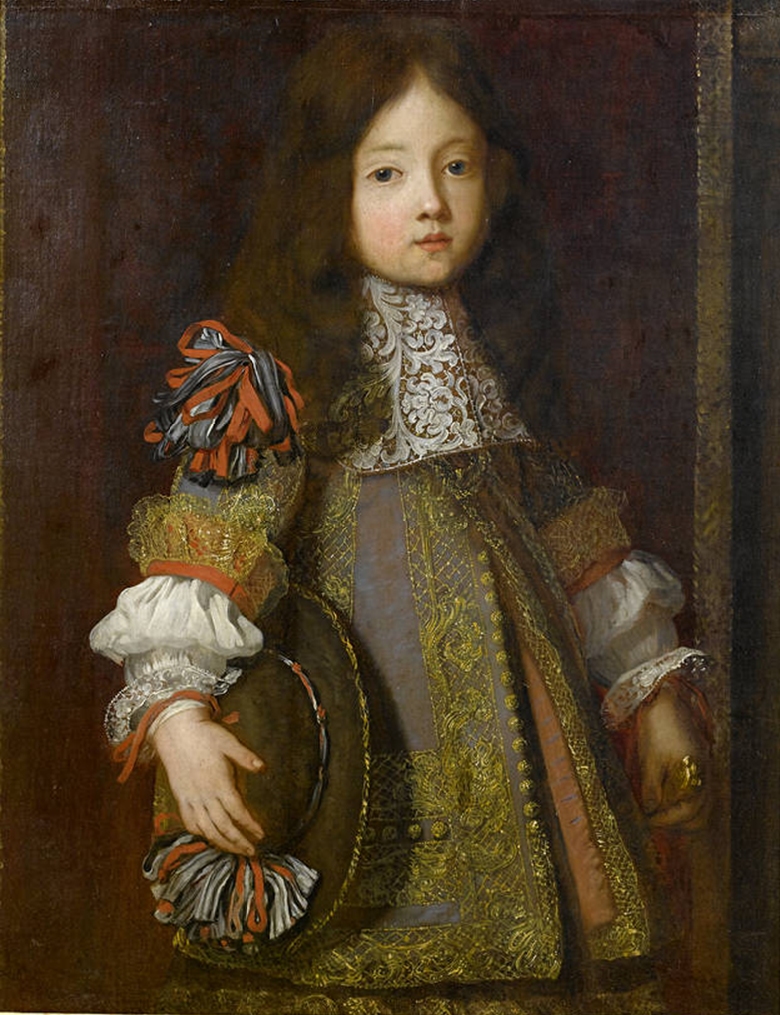There were rumors that he might succeed William Coventry as James’s secretary, and it is strange that he did not. Much lesser men, like Sir Joseph Williamson, took the short step from the civil service into government. But Pepys had no landed estate, he was not in Parliament, and-worst of all- his eyesight was giving way. He sought to leave to go abroad for several months for his health, and he also faced u to the fact that he could no longer keep a diary in crabbed shorthand. His holiday abroad saved his eyesight, but he was shattered by the sudden death of his wife, in November, 1669, at the age of twenty-nine. Though he was childless and increasingly wealthy, he never remarried. Nor did he resume his diary.

—Description
English: Portrait of a Young Boy, oil on canvas, 87.5 × 68.2 cm (34.4 × 26.9 in)
Date 17th century
Source http://www.bonhams.com/eur/auction/15832/lot/13/#
Author Studio of Henri Gascar (1635-1701)—
His public career in the thirty odd years remaining before him was one of mounting success, broken only during the insanity of the Popish Plot, when better men than he suffered a worse fate. As secretary of the Admirality Commission under James II, the Kinghimself being Lord High Admiral, he enjoyed unparalleled power over the navy and made it into a more efficient fighting force than it had ever been. When James was deposed in 1689, he retired from public life, though he was far from abandoning his interests in literature, philosophy, science, and art, which gave him a substantial reputation as a cognoscente. He died in 1703, and was buried beside his wife.

—The collection is largely concerned with the Popish Plot of 1678 (and reactions to it from the period up to 1685), in which Titus Oates pretended to reveal a plot by the Jesuits and leading Catholic laymen to kill the King. The works are bound together in thirteen volumes, placed at classmark Sel.2.114-126. They were collected and annotated by the Verney family of Claydon, Bucks, principally by John Verney (1640-1717), then a merchant in London, who succeeded to the family title in 1696.—Read More:http://www.lib.cam.ac.uk/deptserv/rarebooks/verney.html
Without the diary, these last years are like a drama enacted behind a curtain. The last day Pepys recorded was May 31, 1669. It was much like any other, except that he spent the morning with his clerk, making up his personal accounts. He dined at home, then left for Whitehall, calling on the way on his current mistress, a mature charmer called Betty Mitchell, whose daughter he also fancied:
Dined at home, and in the afternoon by water to White Hall, calling by the way at Michell’s, where I have not been many a day till just the other day, and now I met her mother there and knew her husband to be out of town. And here je did baiser elle, but had not opportunity para hazer some with her as I would have offered if je had had it. And thence had another meeting with the Duke of York, at White Hall, on yesterday’s work, and made a good advance: and so, being called by my wife, we to the Park, Mary Batelier, and a Dutch gentleman, a friend of hers, being with us. Thence to “The World’s End,” a drinking-house by the Park; and there merry, and so home late.

—A painting of intense discomfort as both figures appears to be somewhat ill ease. The eyes of the son are locked with that of the father’s. This father/son relationship is all the more vulnerable and precarious where the monarchy is concerned. James, Duke of York hands his father, the English king Charles 1st a letter opener. His hand on his hip suggests defiance as well as discomfort. While Charles himself looks uncomfortable, there is the suggestion of arrogance in his face. He is king, a noble, and his birthright is to rule. This interesting work is by the German born Sir Peter Lely. He was a very prolific portrait painter in the 17th century and is well known for his works showing the nobility of the day. This royal themed painting is a balanced work as both figures are placed at almost identical points on the canvas. The adornments on James’ sword and sash are richly detailed and have a tactile quality to them.—Read More:http://beautyofbaroque.wordpress.com/
He then added a few words to explanation to his final entry:
And so I betake myself to that course, which is almost as much as to see myself go into my grave: for which, and all the discomforts that will accompany my being blind, the good God prepare me!
And so, the diary comes to an end.








 COMMENTS
COMMENTS



